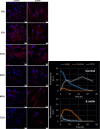Chemical glycomics enrichment: imaging the recycling of sialic acid in living cells
- PMID: 29294191
- PMCID: PMC5959963
- DOI: 10.1007/s10545-017-0118-3
Chemical glycomics enrichment: imaging the recycling of sialic acid in living cells
Abstract
The development of metabolic oligosaccharide engineering (MOE) over the past two decades enabled the bioimaging studies of glycosylation processes in physio-pathological contexts. Herein, we successfully applied the chemical reporter strategy to image the fate of sialylated glycoconjugates in healthy and sialin-deficient patient fibroblasts. This chemical glycomics enrichment is a powerful tool for tracking sialylated glycoconjugates and probing lysosomal recycling capacities. Thus, such strategies appear fundamental for the characterization of lysosomal storage diseases.
Conflict of interest statement
P. A Gilormini, C. Lion, D. Vicogne, Y. Guérardel, F. Foulquier, and C. Biot declare that they have no conflict of interest.
Figures





References
-
- Bardor M, Nguyen DH, Diaz S, Varki A (2005) Mechanism of uptake and incorporation of the non-human sialic acid N-glycolylneuraminic acid into human cells. J Biol Chem 280:4228–4237. 10.1074/jbc.M412040200 - PubMed
-
- Barmherzig R, Bullivant G, Cordeiro D, Sinasac DS, Blaser S, Mercimek-Mahmutoglu S (2017) A new patient with intermediate severe salla disease with hypomyelination: A literature review for salla disease. Pediatr Neurol 74:87–91 - PubMed
Publication types
MeSH terms
Substances
LinkOut - more resources
Full Text Sources
Other Literature Sources
Miscellaneous

